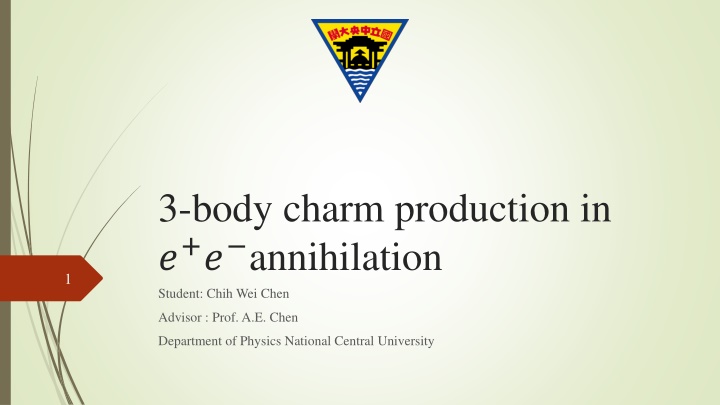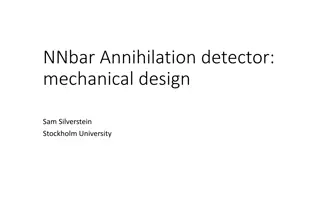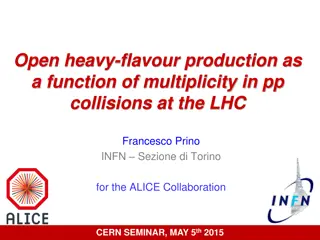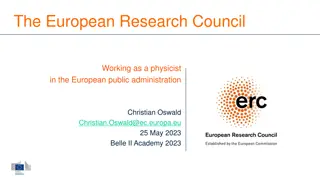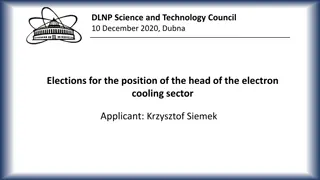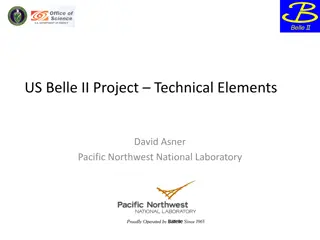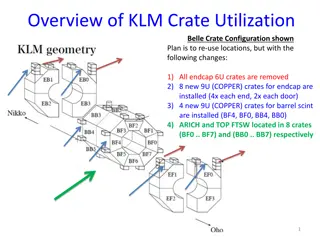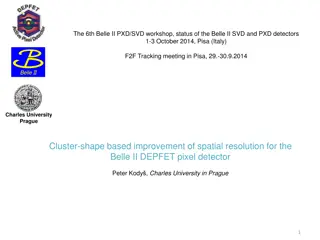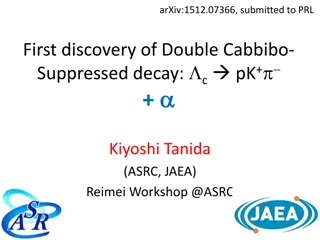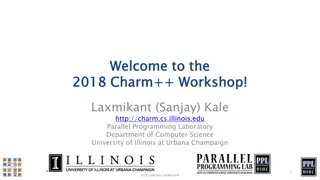Charm Production in Annihilation: Belle Data Analysis
Discussing the study of charm production in annihilation using Belle data analysis, focusing on Monte Carlo simulations and experimental results. Motivations, theoretical models, and event ratios from two-body and three-body production are explored. The analysis involves reconstructing decay channels, implementing selection criteria, and comparing real data with Monte Carlo simulations.
Download Presentation

Please find below an Image/Link to download the presentation.
The content on the website is provided AS IS for your information and personal use only. It may not be sold, licensed, or shared on other websites without obtaining consent from the author.If you encounter any issues during the download, it is possible that the publisher has removed the file from their server.
You are allowed to download the files provided on this website for personal or commercial use, subject to the condition that they are used lawfully. All files are the property of their respective owners.
The content on the website is provided AS IS for your information and personal use only. It may not be sold, licensed, or shared on other websites without obtaining consent from the author.
E N D
Presentation Transcript
3-body charm production in ?+? annihilation Student: Chih Wei Chen 1 Advisor : Prof. A.E. Chen Department of Physics National Central University
Outline 2 Motivation Belle analysis and Monte Carlo result Cross section analysis Non-resonance cross section Resonance cross section Conclusion Future Work References
Motivation 3 String model(Pythia / LUND) Cluster model(Herwig / Weber) Nowadays, it s common to simulate the experimental data with the Monte Carlo in the analysis of high energy physics, and in this way we can analyze much more physical meaning. There are two mathematical models in Monte Carlo to predict the generation status of particles which are Pythia and Herwig (in KEK we use Pythia),
Motivation 4 D meson production from ?+? HERWIG 313 359 PYTHIA 269 1293 2 hadron 3 hadron Event number ratio 0.872 0.067 0.208 0.014 According to table, event ratio from two body and three body production are very different, Herwing is about 0.872 0.067 Pythia is 0.208 0.014 , so we want to know which kind of model is similar to experiment. Regge-cascade hadronization K.Odagiri arXiv:hep-ph/0505315
Belle data analysis Reconstruct ?+? ? ???+.?? 5 Selection and cuts of ? ???+.?? 1. 6 tracks ? = 1??? ? = 1??? Decay channel ? + ???+ ?? ? ?+ 2. PID ?????? > ?.? ???? ?????? < ?.? ???? ? ? ? ? 3. ?? selection ? ? ? ?.??? < ?.?????? 4. ? selection ? ? ? ? ? ? ? ?.???? < ?.??????? 5. ?? selection ? ? ? ?.??? < ?.?????? ? = ???? ?? ??0 ?? 6. ? < ?.???? ? ???? ?? ??? ?? ? ?0 ? ?0 .?? .??
Belle data analysis Reconstruct ?+? ? ? +?? 6 2< 0.12 ?? ? +? 2 2+ ?2 Selection & cuts of ? ? +?? 1. 6 tracks ?2= ???? ?? + ?? ?????0 ?2= ???? ?? + ?? ?????0 Decay channel ? + ???+ ?? ? ?+ 2. PID ?????? > ?.? ???? ?????? < ?.? ???? 3. ?? selection ? ?+? ?.??? < ?.??? 4. ? selection ? ?+? ? ? ?+? ?.???? < ?.???? ?? selection ? ? ?+ ?.??? < ?.??? 5. ?? ? +? 2 ?? ? +? 2 Real Data Monte Carlo 6. ? +selection ? ? ?+?+ ? ? ?+ ?.???? < ?.???? 7. ?? > ?.???? ??= ???? ?? + ?? ?? ? +? ??+ ?? ?< ?.?? ??= ???? ?? + ?? ??? 8.
Belle data analysis Reconstruct ?+? ? ? +?? 7 Before selection Before selection Before selection ? ? + ? ? ? ?0 2 After selection After selection After selection ? ? + ? ? ? ?0 2
Three body kinematics Comparison ??of ? ???+.??between real data and Monte Carlo 8 ??? ??? ? ?? ???? ? ? ? ?0?+.?? Real Data Real Data ???0 ???0 ??? ??? At least one ? s momentum bigger then 2.5 GeV ????? ???? ???0 ???0
9 Three body kinematics Comparison ??of ? +? ?? between real data and Monte Carlo ??? ??? ??? ??? + ??? + ??? + Real Data ????? ???? ?? distribution of real data and Monte Carlo are different Monte Carlo 1 1 density is highest ? ?0?+.?? Distributed on ??? = 1 or ???0= 1 ? +? ?0 Distributed on ??? += 1 or ??? = 1
Cross section analysis 10 According to previous slide, three body production can be separate to two case : 1. Non-resonance state production : Pure three body cross section a) Identify resonance from real data and count number. b) Use total event number minus resonance event number to get non-resonance event number. c) Analysis efficiency by Xp and decide which method is more satisfying to calculate cross section from real data. Differential cross section Total cross section 2. Resonance state production : a) Resonance cross section estimate b) Identify resonance in D meson mass spectra
Identify resonance from ?+? ? ???+.?? production 11 [5] ? ? = ? ? ??1?+?2?2 ??3+?4?+?5?2 ??? ? ?0 ??? ? > ?0 1 ?2 ??+ ?? 2?2 ?? ?? 2 ? ? ? ? 2? Type Total number ?0?124200 ?0?2 ?0? 27500 ? 2010 ? 2010 ? 2010 ?12420 ? 2010 ?2 ? 2010 ? 2750 Resonance state Non-Resonance state Number 471 21.70 11.96 6.40 28.90 7.2 13.37 5.61 122 11.04 25.94 6.58 26.73 8.68 17.99 6.04 246.89 38.04 224.11 29.53 2460 ? ?0?+ ? ?0?+ .?? Remove ? ? .?? 2460 ? ? ? ? ? ?
Non-resonance cross section analysis ?+? ? ???+.?? 12 ??? ?0?+.?????? ????0 Use Monte Carlo generate ?+? ? ?0?+.?? ? ????? ????? ????? = 227872 ? ????? ????? ?????? = 56178 ? ? ????? ????? ?????? ? ????? ????? ????? 56178 227872 0.247 0.001 = Remove resonance in real data to get pure ?+? ? ?0?+.??event value Pure ?+? ? ?0?+.??number Efficiency Statistics correction ?? 1 Pure three body cross section ?? 224.11 29.53 0.247 0.001 909.05 120.05 871.77 997.27 131.41
Identify resonance from ?+? ?+??? production 13 Type Total Number ? ?2 Non-Resonance state Number 128 11.31 26.63 7.59 101.37 13.62 2460 ? ? ?0
Non-resonance cross section analysis ?+? ? ? +?? 14 Real Data ??? ? +?0 ???? +???? Efficiency of each bin are very different, so we can not use average efficiency, we use different cross section. Remove statistics in red cycle and calculate cross section bin by bin. 2460 = 26.63 7.59 Remove ? ? ?2 Statistics in this bin 7.37 9.57
Non-resonance cross section analysis ?+? ? ? +?? Differential Cross Section 15 Cross Section ?? Cross Section ?? ??? +,??? ??? +,??? 19.51 25.34 62.52 4.86 26.03 4.15 11.49 3.36 65.98 5.03 34.28 4.43 5.61 3.02 7.56 3.50 20.17 4.81 63.23 5.35 11.23 3.59 13.29 3.90 27.56 5.08 12.44 4.49 13.74 3.97 7.52 3.49 45.88 5.77 47.60 6.68 12.37 4.48 15.81 5.06 16.00 5.09 63.61 8.56 1.0,1.0 1.0,0.9 1.0,0.7 1.0,0.6 0.9,1.0 0.9,0.9 0.9,0.7 0.9,0.6 0.9,0.4 0.7,1.0 0.7,0.9 0.7,0.7 0.7,0.6 0.7,0.4 0.6,1.0 0.6,0.9 0.6,0.7 0.9,0.4 0.4,0.7 0.4,0.6 0.3,0.7 0.1,0.9 Sum of cross section 603.43 35.69 ??
????+.??resonance cross section analysis 16 Use Monte Carlo to generate ?+? ? ?12420 ?+? ?0?124200 .?? 2460 ?+? ? ?2 ?+? ?0?2 24600 ?+? ?0?124200 ?+? ?0?2 2460 24600 ?+? ? ?12420 25.94 6.58 0.278 0.001 0.677 0.03592 ???124200 104.48 26.50 ???124200 ?+? ? ?2 26.73 8.68 0.277 0.001 0.677 0.03592 ???2 107.66 28.47 ???2 .?? .?? Statistics Efficiency 11.96 6.40 0.278 0.001 0.677 0.03592 ???12420 48.17 25.78 ???12420 28.90 7.2 0.277 0.001 0.677 0.03592 ???2 116.40 29.00 ???2 Branching Ratio 24600 2460 Cross section (fb) 24600 2460
Resonance cross section estimate ?? 17 ?????Branching ratio estimate Result from BaBar Collaboration (PhysRevD.82.111101) ? ?2 ? ?2 Assume ?2 Collaboration)) : ?2 ?2 ?2 ?2 24600 ?+? 24600 ? +? = 1.47 0.03 0.16 24600only have four decay channel(arXiv:hep-ex/0601025 v2 18 Apr 2006(KLOE 24600 ? +? 24600 ?+? 24600 ? 0?0 24600 ?0?0 ? ??0 ?+? ? ? ?+? Assume Apr 2006(KLOE Collaboration)) ? ? ?0?0 2.255 0.005( arXiv:hep-ex/0601025 v2 18 ? ??0 ?0?0 24600 ? +? = 0.280 0.120 ? ?2 24600 ?+? = 0.412 0.177 ? ?2 24600 ?0?0= 0.183 0.078 ? ?2 24600 ? 0?0= 0.124 0.053 ? ?2
?+? ?0?? ??6?0 ?+? ????????? ??6? ?+? ? ?? ?+? ? ?????? statistics 11.96 6.40 28.90 7.2 25.94 6.58 26.73 8.68 efficiency 0.278 0.001 0.277 0.001 0.278 0.001 0.277 0.001 Branching ratio without error 0.677 0.03592 ???2 0.677 0.03592 ???12420 0.677 0.03592 ???2 0.677 0.03592 ???124200 24600 2460 107.66 28.47 ???2 116.40 29.00 ???2 104.48 26.50 ???12420 48.17 25.78 ???124200 Cross Section ?? 24600 2460 Branching estimate 24600 ? +? 24600 ? +? 24600 ?0?0 24600 ?0?0 ?? ?2 = 0.280 0.120 ?? ?2 = 0.280 0.120 ?? ?2 = 0.183 0.078 ?? ?2 = 0.183 0.078 Cross Section estimate ?? 172.04 92.07 73.73 570.93 144.81 61.72 588.31 155.57 66.31 415.71 103.57 44.39
Comparison between pure two body and three body 19 Pure two and three body cross section ratio ? ? +? ? ? +? ?0 ? ? ? ? ? ?0?+ Value 660 30 603.43 35.69 1.093 0.082 750 40 997.27 131.41 0.752 0.036 .?? K.Odagiri simulation : Herwig Pythia From table we learn our result are similar with Cluster model(Herwig) ? 2 ?????? ? 2 ?????? ? 3 ?????? = ? 3 ?????? = 313 17.69 269 16.40 359 18.95 =0.872 0.067 1293 35.96 =0.208 0.014
Comparison between Vector and Pseudoscalar 20 Our result : pure ?+? ??? T.Uglov : exclusive ?+? ?? Production mode Fill Cross Section Production mode Fill Cross Section ?? ? +?0 ?? ?0?+.?? ?? ? + ?? ? ? ?+? ? ?+? 603.43 35.69 ?? 660 30 ?? ? ?+? ? ?+? ?????? ???????????? ? ?+? 997.27 131.41 ?? 750 40 ?? ratio ratio ?????? ???????????? ? ?+? ?? ? +?0 ?? ? + 0.605 0.087 0.88 0.06 ?? ?0?+.?? ?? ? ? ?+? ? ?+? CLEO Collaboration Phy rev. D 70, 112001 (2004) : inclusive ?+? ?? (assuming there is no resonance s mass higher then ? ) Production mode Cross Section Production mode Cross Section ? ?+? ? 0? ? ?+? ?0X ?????? ???????????? ?+? ? 0? ?+? ?0? ? ?+? ? +? ? ?+? ?+X ?????? ???????????? ?+? ? +? ?+? ?+? 616 32 ?? 541 7.16 ?? Ratio 578 10 ?? 455 7.16 ?? Ratio 1.14 0.06 1.27 0.03
Comparison between Vector and Pseudoscalar 21 Our result : pure ?+? ??? ? ?+? ?? ? +?0 = 0.605 0.087 ?? ?0?+.?? ? ?+? T.Uglov : exclusive ?+? ?? ? ?+? ?? ? + = 0.88 0.06 ?? ? ? ?+? CLEO Collaboration : inclusive ?+? ?? (assuming there is no higher resonance) ?+? ? 0? ?+? ?0? ?+? ? +? ?+? ?+? Our result is similar to T.Uglov s result = 1.14 0.06 = 1.27 0.03 CLEO Collaboration ratio is bigger then our result which mean there are resonance contribution Analysis ?????? ???????????? must consider higher resonance
Identify resonance in D meson mass spectra ?+? ? ? 2750 ?+? ?0 ? 27500 2460 24600 ?+? ? ?2 ?+? ?0 ?2 2S ? 2750 ? ?3 ?327500 ? ?+? ? ?12420 ?+? ?0 ?124200
Conclusion 23 Non-resonance cross section ?? ?0?+.??= 997.27 131.41 ?? ?? +? ?0 = 603.43 35.69 ?? Ratio between two body production and three body is similar with Cluster model(Herwig) In Xp 2D figure events are distributed in the direction of Xp = 1, because ? usually move forward together with D in center mass frame Vector Pseudoscalar ratio Pure multi-body analysis is the better way to calculate Vector Pseudoscalar ratio Resonance cross section estimate ??0 ?124200 = 172.04 92.07 73.73 ?? ??0?224600 = 415.71 103.57 44.39 ?? ?? +?12420 = 570.93 144.81 61.72 ?? ?? +?22460 = 588.31 155.57 66.31 ??
Future Work 24 Consider other decay channel ?0 ? ?+? ?+(In ?+? ? ?0?0.?? case we can have 4 times statistics) Wait for Belle-2 result(50 times statistics) Analysis other production mode ?+? ? ? ?0 ?+? ? ?0?+.?? Analysis four body production, then comparison between pure two body three body four body to know Mechanism of particle generation. Analysis resonance state form factor Identify other resonance state from ?+? ??? production
References 25 [1]K. Odagiri, Regge-cascade hadronization , arXiv:hep-ph/0606315 v1, 30 Jun 2006 [2]K.A.Olive et al. (Particle Data Group), Chin. Phys. C, 38, 090001 (2004) and 2015 updata [3] C. Patrignani et al. (Particle Data Group), Chin. Phys. C, 40, 100001 (2016) and 2017 update [4] J.D. Jackson et al (LBNL) January 2000 and D.R. Tovey (Sheffield) June 2008 Revised http://pdg.lbl.gov/2017/reviews/rpp2017-rev-kinematics.pdf http://pdg.lbl.gov/2017/reviews/rpp2017-rev-kinematics.pdf [5] P.delAmo Sanchez, Observation of new resinances decaying to ?? and ? ? in inclusive ?+? collisions near ? = 10.58 GeV PHYSICAL REVIEW D 82, 11101(R) (2010) [6] Belle official power point http://belle.kek.jp/group/software/misc_slides/belle_ana- 080902.pdf [7] T.Uglov, (Belle note) Measurement of ?+? ? +? cross-sections ,14 Dec 2003 [8] M. Artuso, (CLOEO Collaboration ) Charm meson spectra in ee annihilation at 10.5 GeVcenter of mass energy PHYSICAL REVIEW D 70, 112001 (2004) [9] https://upload.wikimedia.org/wikipedia/commons/c/c2/KEKB.png [10] K. Abe, (CLOEO Collaboration ) Study of ? ? 0? ? 0 ? +? decays arXiv:hep-ex/0307021v1 9 Jul 2003 http://belle.kek.jp/group/software/misc_slides/belle_ana-080902.pdf http://belle.kek.jp/group/software/misc_slides/belle_ana-080902.pdf https://upload.wikimedia.org/wikipedia/commons/c/c2/KEKB.png
26 End~
27 Back up
28 ??? + 2460 is distributed in 0.92 < ??< 1, from ??? + ? ?2 and ??? relationship figure, we know ? ?2 body s event are local at 1,1 , so we use ? ?2 body s statistics minus total statistics : 34 5.83 26.63 7.59 = 7.37 9.57 Cross Section 19.51 25.34 ?? 2460 two 2460 two ???
D*+ D0 29 D*0 D+
Inclusive Cross sections D+ 640 14 D0 1550 16 D*+ 578 10 D*0 616 32 Assuming there is NO higher mass resonances Like D(2420), D(2460) .. D*0 D0100%; no D+ D*+ D068%; D+32% Exclusive cross sections: D+= 640 578*0.32 = 455 D0= 1550 616 578*0.68 = 541 ? ?? ? 0?0= 616 32 ? +?+= 578 10 31 541 36.41 = 1.14 0.09 455 14.36 = 1.27 0.04
32 Particle Width(MeV) type Mode ?0?+ ?+?0 ?+? Fraction 67.7 0.5 % 30.7 0.5 % 1.6 0.4 % ? 2010+ 0.834 1.8 ??? 2400+ ?0?+ ?0?+ ?+?0 24000?+ ? 20070?+ ? +?+? ?+? ? ?0?+ ? 0?+ ?+? ? ? +? ? ?0 230 17 ???? ??? ???? ??? ??? ?0 ?12420+ 25 6 ??? ???? ??? ???? ???? ???? ???? ??? ???? ??? ???? ? ??? ??? 2460+ ?2 46.7 1.2 ? ???
Particle ?0 Width(MeV) 267 40 type ??? Mode ?+? Fraction ???? ???? ??? ???? 33 24000 ? 2010+? ?+? ?0?0 ?0?0500 ?0 ?0?+?+ ? 0?+?+ ? 2010+? ?+? ? 2010+? ?0?+? ? 0?+? ? +? ?0?+ ? +? ??? ?124200 31.7 2.5 2400+? ???? ??? ???? ???? ???? ???? ??? ???? ??? ???? ???? ???? ???? ? ??? ?124300 ??? 384 74 ??? 24600 ?2 47.5 1.1 ? ??? ? 27400 73.2 13.4 ??? ???? ??? ?? 66 5
34 ??0
D meson spectra Pythia Herwig 38 ?+? ? ?0?+.?? ?+? ? +? ?0 inclusive ?????? ???????????? exclusive ??? form factor Herwig
Herwig 39 ?+? ? +? ?+? ?+? ? ? ?+? topology Resonance 1. 1 3 3 1 2. 3. 2 2 +2 4. 4 body kinematics 5. Pure 4 body cross section
